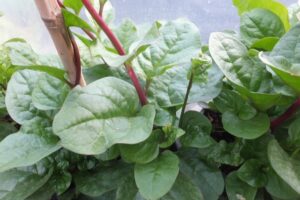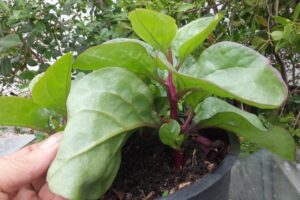
Without a greenhouse this tropical climbing vegetable, Basella, is hardly worth attempting thus it’s little known in the UK though with a plethora of common names indicating worldwide popularity. Vine Spinach, Indian Spinach, Malabar Spinach, Ceylon Spinach, Gambian Spinach, Malabar Nightshade to name but a few. Originally growing wild in much of the East it’s now on every continent.

Because it’s tender has meant it’s effectively been confined to warmer country cuisines especially Indian. So though this was introduced to the UK as early the Seventeenth century it never caught on, only slightly more accepted in France, though then of course solely in the warmer south. With modern commercial protected cropping though this could now become a valuable cash crop in Britain.

The huge popularity as a spinach is for the thick succulent leaves and tender young shoots which are excellent, these also go well in stir-fries, being bland with a slight hint of Basil. But as a decorative greenhouse plant this is also very appealing, and being a climber gives a lot of display. The flowers are not large but come in great numbers along the shoots. (If allowed to become ripe fruits these can be used to make ink.)

Basella is perennial but usually grown as an annual as the returns are much better. Seed is sown in the warm from early spring, grown on then potted up into tubs making strong plants from early summer. These can be multiplied further by striking cuttings which root readily. Basella is not fussy as to compost preferring a sandy mix with plentiful organic matter such as compost or leaf-mould.

Pest and diseases are few other than the usual molluscs. However watering must be regular and plentiful or not enough new leaves will be produced as the plants rush into flower. If this occurs vines can be cut down to knee high and new growth will soon replace the old. Indeed for commercial production these are not grown as vines but as short bushes cut back for a crop every few weeks. However for decorative use, with only a few leaves taken for occasional stir fries, then let the plants climb canes, they’ll make six or seven feet.

There are two forms Basella rubra, and Basella rubra var. alba, the former being red stemmed and the latter greenish to white, each are preferred by different markets. From the greenhouse specimen point of view the standard red is by far the better choice.


